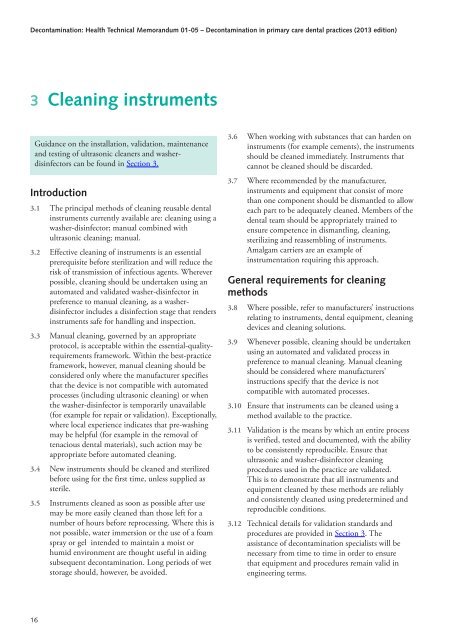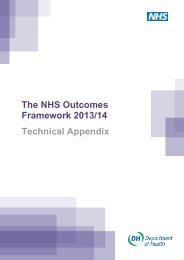Decontamination in primary care dental practices - Gov.uk
Decontamination in primary care dental practices - Gov.uk
Decontamination in primary care dental practices - Gov.uk
Create successful ePaper yourself
Turn your PDF publications into a flip-book with our unique Google optimized e-Paper software.
<strong>Decontam<strong>in</strong>ation</strong>: Health Technical Memorandum 01-05 – <strong>Decontam<strong>in</strong>ation</strong> <strong>in</strong> <strong>primary</strong> <strong>care</strong> <strong>dental</strong> <strong>practices</strong> (2013 edition)3 Clean<strong>in</strong>g <strong>in</strong>strumentsGuidance on the <strong>in</strong>stallation, validation, ma<strong>in</strong>tenanceand test<strong>in</strong>g of ultrasonic cleaners and washerdis<strong>in</strong>fectorscan be found <strong>in</strong> Section 3.Introduction3.1 The pr<strong>in</strong>cipal methods of clean<strong>in</strong>g reusable <strong>dental</strong><strong>in</strong>struments currently available are: clean<strong>in</strong>g us<strong>in</strong>g awasher-dis<strong>in</strong>fector; manual comb<strong>in</strong>ed withultrasonic clean<strong>in</strong>g; manual.3.2 Effective clean<strong>in</strong>g of <strong>in</strong>struments is an essentialprerequisite before sterilization and will reduce therisk of transmission of <strong>in</strong>fectious agents. Whereverpossible, clean<strong>in</strong>g should be undertaken us<strong>in</strong>g anautomated and validated washer-dis<strong>in</strong>fector <strong>in</strong>preference to manual clean<strong>in</strong>g, as a washerdis<strong>in</strong>fector<strong>in</strong>cludes a dis<strong>in</strong>fection stage that renders<strong>in</strong>struments safe for handl<strong>in</strong>g and <strong>in</strong>spection.3.3 Manual clean<strong>in</strong>g, governed by an appropriateprotocol, is acceptable with<strong>in</strong> the essential-qualityrequirementsframework. With<strong>in</strong> the best-practiceframework, however, manual clean<strong>in</strong>g should beconsidered only where the manufacturer specifiesthat the device is not compatible with automatedprocesses (<strong>in</strong>clud<strong>in</strong>g ultrasonic clean<strong>in</strong>g) or whenthe washer-dis<strong>in</strong>fector is temporarily unavailable(for example for repair or validation). Exceptionally,where local experience <strong>in</strong>dicates that pre-wash<strong>in</strong>gmay be helpful (for example <strong>in</strong> the removal oftenacious <strong>dental</strong> materials), such action may beappropriate before automated clean<strong>in</strong>g.3.4 New <strong>in</strong>struments should be cleaned and sterilizedbefore us<strong>in</strong>g for the first time, unless supplied assterile.3.5 Instruments cleaned as soon as possible after usemay be more easily cleaned than those left for anumber of hours before reprocess<strong>in</strong>g. Where this isnot possible, water immersion or the use of a foamspray or gel <strong>in</strong>tended to ma<strong>in</strong>ta<strong>in</strong> a moist orhumid environment are thought useful <strong>in</strong> aid<strong>in</strong>gsubsequent decontam<strong>in</strong>ation. Long periods of wetstorage should, however, be avoided.3.6 When work<strong>in</strong>g with substances that can harden on<strong>in</strong>struments (for example cements), the <strong>in</strong>strumentsshould be cleaned immediately. Instruments thatcannot be cleaned should be discarded.3.7 Where recommended by the manufacturer,<strong>in</strong>struments and equipment that consist of morethan one component should be dismantled to alloweach part to be adequately cleaned. Members of the<strong>dental</strong> team should be appropriately tra<strong>in</strong>ed toensure competence <strong>in</strong> dismantl<strong>in</strong>g, clean<strong>in</strong>g,steriliz<strong>in</strong>g and reassembl<strong>in</strong>g of <strong>in</strong>struments.Amalgam carriers are an example of<strong>in</strong>strumentation requir<strong>in</strong>g this approach.General requirements for clean<strong>in</strong>gmethods3.8 Where possible, refer to manufacturers’ <strong>in</strong>structionsrelat<strong>in</strong>g to <strong>in</strong>struments, <strong>dental</strong> equipment, clean<strong>in</strong>gdevices and clean<strong>in</strong>g solutions.3.9 Whenever possible, clean<strong>in</strong>g should be undertakenus<strong>in</strong>g an automated and validated process <strong>in</strong>preference to manual clean<strong>in</strong>g. Manual clean<strong>in</strong>gshould be considered where manufacturers’<strong>in</strong>structions specify that the device is notcompatible with automated processes.3.10 Ensure that <strong>in</strong>struments can be cleaned us<strong>in</strong>g amethod available to the practice.3.11 Validation is the means by which an entire processis verified, tested and documented, with the abilityto be consistently reproducible. Ensure thatultrasonic and washer-dis<strong>in</strong>fector clean<strong>in</strong>gprocedures used <strong>in</strong> the practice are validated.This is to demonstrate that all <strong>in</strong>struments andequipment cleaned by these methods are reliablyand consistently cleaned us<strong>in</strong>g predeterm<strong>in</strong>ed andreproducible conditions.3.12 Technical details for validation standards andprocedures are provided <strong>in</strong> Section 3. Theassistance of decontam<strong>in</strong>ation specialists will benecessary from time to time <strong>in</strong> order to ensurethat equipment and procedures rema<strong>in</strong> valid <strong>in</strong>eng<strong>in</strong>eer<strong>in</strong>g terms.16
















